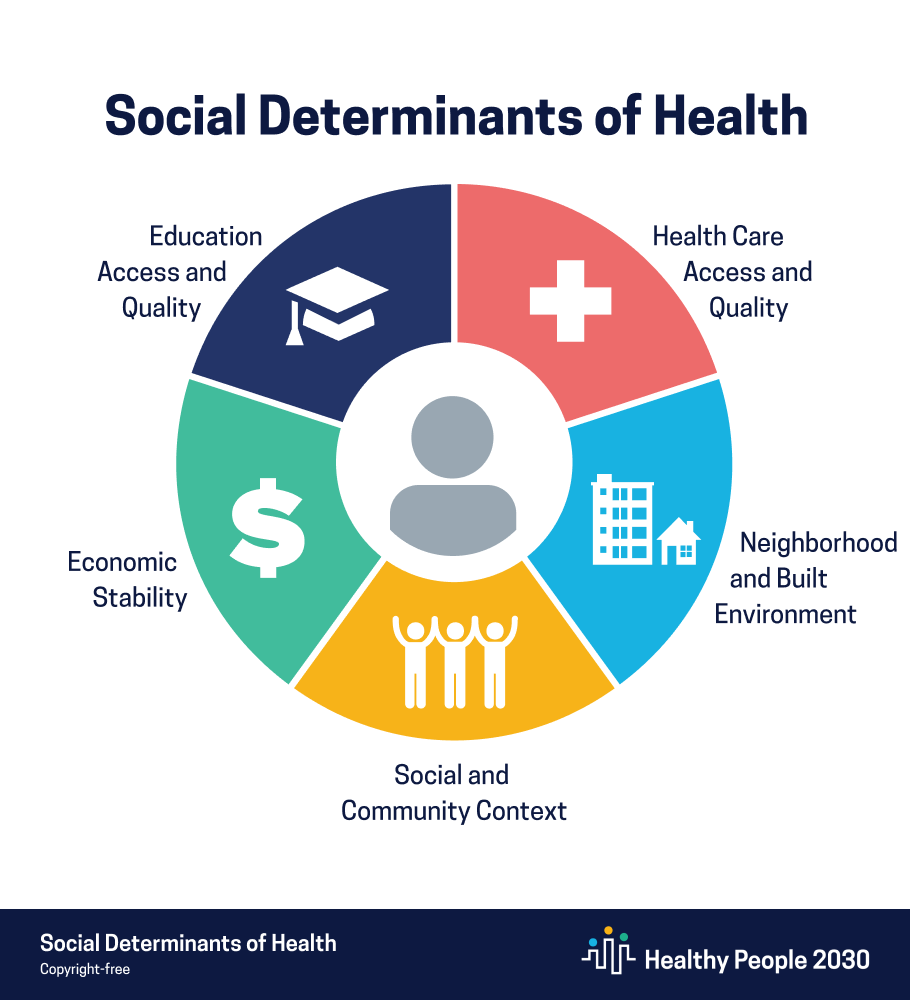Review: What are SDoH?
WHO
Social determinants of health (SDoH) are defined as:
The conditions in which people are born, grow, work, live, and age, and the wider set of forces and systems shaping the conditions of daily life.
These forces and systems include:
- Economic policies and systems.
- Development agendas.
- Social norms.
- Social policies.
- Political systems.
Source: WHO
Addressing SDoH appropriately is fundamental for improving health and reducing longstanding inequities in health, which requires action by all sectors and civil society.
- Income and social protection.
- Education.
- Unemployment and job insecurity.
- Working life conditions.
- Food insecurity.
- Housing, (basic amenities and the environment).
- Early childhood development.
- Social inclusion and non-discrimination.
- Structural conflict.
- Access to affordable health services of decent quality.
Why is addressing SDoH important?
Accelerates progress toward health equity
Addressing differences in SDoH accelerates progress toward health equity, a state in which every person has the opportunity to attain their highest level of health (CDC).
Health equity and health literacy
SDoH are one of three priority areas for Healthy People 2030, along with health equity and health literacy. Healthy People 2030 sets data-driven national objectives in five key areas (see next important point).
SDoH can be grouped into 5 domains
Healthy People 2030
- Economic stability.
- Education access and quality.
- Health care access and quality.
- Neighborhood and built environment.
- Social and community context.
Source: OSHA, Healthy People 2030

Economic stability
OHSA, Healthy People 2030
- Definition
- Importance
- Challenges
- Strategies
Economic stability refers to the ability of individuals to earn steady incomes that allow them to meet their health needs.
Economic stability is crucial for accessing essential resources such as:
- Healthy foods.
- Healthcare.
- Housing.
- Poverty: In the United States, a little more than 1 in 10 people live in poverty (11.5% U.S. Census data 2024), which limits their ability to afford necessary health-related resources.
- Employment: Steady employment reduces the likelihood of living in poverty and improves health outcomes. However, many people face difficulties in finding and maintaining jobs.
- Disabilities and health conditions: Individuals with disabilities or chronic health conditions may have limited work opportunities.
To improve economic stability, we must include:
- Employment programs: Initiatives that provide job training, career counseling, and high-quality childcare can help individuals find and keep jobs.
- Supportive policies: Policies that assist with food, housing, healthcare, and education can reduce poverty and enhance health and well-being.
Education access and quality
OHSA, Healthy People 2030
- Definition
- Importance
- Challenges
- Strategies
Education access and quality refer to the availability of high-quality educational opportunities for all individuals, regardless of their socioeconomic status.
Higher levels of education are associated with better health outcomes and longer life expectancy.
- Socioeconomic barriers: Children from low-income families often face difficulties in accessing high-quality education, which can affect their academic performance and future opportunities.
- Disabilities and discrimination: Children with disabilities and those who experience social discrimination, such as bullying, are more likely to struggle academically.
- School quality: Some children live in areas with poorly performing schools, which can limit their educational achievements.
To improve education access and quality, we must include:
- Early childhood education: Programs that provide high-quality early childhood education can help children develop essential skills and improve their long-term academic success.
- Supportive interventions: Interventions that support children and adolescents in their academic journey, such as tutoring and mentoring programs, can enhance their educational outcomes.
- Financial assistance: Policies that help families afford higher education, such as scholarships and grants, can increase access to college and improve future job prospects.
Health care access and quality
OHSA, Healthy People 2030
- Definition
- Importance
- Challenges
- Strategies
Health care access and quality refer to the availability and standard of health care services that individuals can receive.
Access to high-quality health care is essential for:
- Preventing and treating illnesses.
- Improving quality of life.
- Increasing life expectancy.
- Insurance coverage: About 1 in 10 people (8% U.S. Census data, 2023) in the United States do not have health insurance, making it difficult for them to afford necessary health care services. In 2022, approximately 23% of working-age adults with health insurance were considered underinsured, (i.e., their coverage did not provide affordable access to healthcare).
- Primary care providers: Many people lack a primary care provider, which can lead to missed preventive services and delayed treatment.
- Geographic barriers: Some individuals live in areas with limited access to health care providers, which affects their ability to receive timely care.
To improve health care access and quality, we must include:
- Increase insurance coverage: Strategies to increase insurance coverage rates are critical for ensuring more people can access essential health care services.
- Enhance primary care: Improving access to primary care providers and enhancing communication between patients and providers can help more people receive the care they need.
- Telehealth services: Expanding telehealth services can help overcome geographic barriers and provide timely care to individuals in remote areas.
Neighborhood and built environment
OHSA, Healthy People 2030
- Definition
- Importance
- Challenges
- Strategies
Neighborhood and built environment refer to the physical and social environments in which people live, work, learn, and play.
The quality of these environments significantly impacts health outcomes, including:
- Safety.
- Access to resources.
- Overall well-being.
- Violence and crime: High rates of violence and crime in neighborhoods can lead to stress, injury, and reduced physical activity.
- Environmental hazards: Exposure to unsafe air, water, and other environmental hazards can cause various health issues.
- Lack of infrastructure: Insufficient infrastructure, such as sidewalks and bike lanes, can limit opportunities for physical activity and social interaction. “Food deserts” lack access to healthy food options.
To improve neighborhoods and built environments, we must include:
- Community planning: Implementing community planning initiatives that focus on creating safe, accessible, and healthy environments can improve residents’ quality of life.
- Policy interventions: Policies that address environmental hazards, improve infrastructure, and reduce crime can significantly enhance neighborhood safety and health.
- Promote physical activity: Creating opportunities for physical activity, such as parks and recreational facilities, can improve physical and mental health.
Social and community context
OHSA, Healthy People 2030
- Definition
- Importance
- Challenges
- Strategies
Social and community context refers to the social relationships and community environments that influence an individual’s health and well-being.
Strong social support networks and positive community environments are crucial for mental and physical health.
- Social isolation: Many individuals experience social isolation, which can lead to mental health issues such as depression and anxiety.
- Discrimination and inequity: Discrimination and social inequities can negatively impact health by creating chronic and acute stress and limiting access to resources.
- Community safety: Unsafe community environments can deter physical activity and increase the risk of injury.
To improve supportive social and community context, we must include:
- Build social support networks: Programs that foster social connections and support networks can improve mental health and well-being.
- Address discrimination: Policies and initiatives that address discrimination and promote equity can enhance community health.
- Enhance community safety: Efforts to improve community safety, such as neighborhood watch programs and better lighting, can encourage physical activity and reduce crime.


